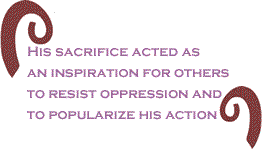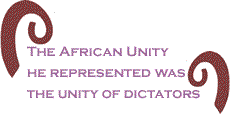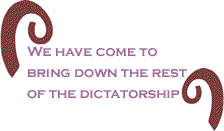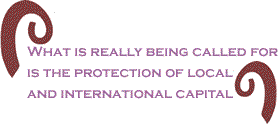|
The
full explosion of the Tunisian revolutionary process is
now taking root across Africa, far beyond the town of Sidi
Bouzid, from where Mohammed Bouazizi had sent a message
to youths all across the world that they should stand up
against oppression.  The
overthrow and the removal of the dictator, Zine al-Abidine
Ben Ali on January 14, 2011 was an important stage in this
revolution. When this dictator (who was a top ally of the
USA and France), fled to Saudi Arabia, dictators and corrupt
party leaders all over the world trembled as the popular
power in the streets found support in all parts of Africa,
the Middle East and parts of Europe. This revolution in
Tunisia is a typical example of the self mobilization of
ordinary people for their own emancipation independent of
a vanguard party or self proclaimed revolutionaries. The
iteration of the Tunisian revolution in other parts of Africa/Middle
East it is fast becoming a pattern that speaks volume about
the nature of 21st century revolutions. The
overthrow and the removal of the dictator, Zine al-Abidine
Ben Ali on January 14, 2011 was an important stage in this
revolution. When this dictator (who was a top ally of the
USA and France), fled to Saudi Arabia, dictators and corrupt
party leaders all over the world trembled as the popular
power in the streets found support in all parts of Africa,
the Middle East and parts of Europe. This revolution in
Tunisia is a typical example of the self mobilization of
ordinary people for their own emancipation independent of
a vanguard party or self proclaimed revolutionaries. The
iteration of the Tunisian revolution in other parts of Africa/Middle
East it is fast becoming a pattern that speaks volume about
the nature of 21st century revolutions.
At the time of writing
this piece, the revolution is going through the third stage
where the popular forces are seeking a drastic change in
the politics of the society and demanding new order in Tunisia
based on freedom, democracy and social justice. In short
,the people were calling for a form of popular democracy
that moves beyond alienation, and beyond the separation
of politics and economics. The first stage of the revolution
started with the self-immolation and self sacrifice of Mohammed
Bouazizi in the region of Sidi Bouzid. The unemployed graduate,
Bouazizi, set himself on fire to protest police brutality
after they harassed and stopped him from selling fruits
and vegetables which was his only means of livelihood.
The second stage involved the mass organization and the
deployment of new networks for revolution among the youth
and the working people leading to the popular overthrow
of the dictator. The Third stage involved the merger of
the caravans of liberation into Tunis, the capital with
the break in the ranks of the forces of coercion. It was
at this stage that the true revolutionary character of the
self organization started to emerge. At this third stage,
the prolonged popular protest of the organized poor with
women and youth taking the lead in calling for the arrest
of the dictator and for a new government of the people.
It is at this delicate stage of this revolution that it
is most necessary for revolutionaries all over the world
to stand together with the Tunisians, and to draw the positive
lessons that can spread the revolution like a fire to burn
off the corruption and destruction of capitalism and neoliberalism.
 The
capitalist classes have been wounded in Tunisia and they
want to do all within their power to contain this new wave
of revolution. However, their ability to undermine this
revolution will depend on the vigilance and support of revolutionaries
internationally. We must remember that revolutions are made
by ordinary people and that there are millions who want
a new form of existence where they can live like decent
human beings. In another era of capitalist depression and
war it was C. L. R. James who commented that, “That is the
way a revolution often comes, like a thief in the night,
and those who have prepared for it and are waiting for it
do not see it, and often only realise that their chance
has come when it has passed.” The
capitalist classes have been wounded in Tunisia and they
want to do all within their power to contain this new wave
of revolution. However, their ability to undermine this
revolution will depend on the vigilance and support of revolutionaries
internationally. We must remember that revolutions are made
by ordinary people and that there are millions who want
a new form of existence where they can live like decent
human beings. In another era of capitalist depression and
war it was C. L. R. James who commented that, “That is the
way a revolution often comes, like a thief in the night,
and those who have prepared for it and are waiting for it
do not see it, and often only realise that their chance
has come when it has passed.”
James was referring
to the Chinese masses who had led the way in the revolutionary
process in China. The real point of Tunisia as in China
is that in every revolutionary situation it is the real
action of human beings taking to the streets, defying the
police and fighting with courage and imagination that changes
society. Revolutionaries should grasp the epoch making process
that is now underway in the world. How this epoch making
process will mature across Africa, Europe and Asia will
depend on the politics and organisations that shape the
movement in the coming weeks and months. Revolutionaries
must learn the positive lessons: the new pattern of 21st
century revolution, the new forces of revolution, and the
new tools of revolutionary struggles that are being fashioned
by those who are making sacrifices for a new mode of social
existence.
Self-immolation,
Sacrifices and Self-organization
Within a month, the
narrative in the international media on Tunisia has changed
completely. Prior to the present uprising against the capitalist
classes and the dictator, Tunisia was represented in the
Western media as a stable free market economy that was a
symbol of the success of capitalism, a top ally of the USA
in the war against terrorism. Tunisia was the choice destination
for European tourists as the same European states shut their
doors to migrants from Africa.  Behind
the image of Tunisia as a stable tourist resort where the
Europeans could relax was the reality of repression, corruption,
censorship and massive exploitation of the people. The concentration
and centralization of wealth and power in the hands of the
ruling family alienated even members of the capitalist classes
who were locked out of the inner circles of opulence and
obscene wealth. In the midst of struggle, there was unemployment
and suffering. Mohammed Bouazizi, a youth who had sought
to dignify his existence by becoming a fruit an d vegetable
seller, decided to make a sacrifice to make a stand against
oppression and made a break with the politics of obedience. Behind
the image of Tunisia as a stable tourist resort where the
Europeans could relax was the reality of repression, corruption,
censorship and massive exploitation of the people. The concentration
and centralization of wealth and power in the hands of the
ruling family alienated even members of the capitalist classes
who were locked out of the inner circles of opulence and
obscene wealth. In the midst of struggle, there was unemployment
and suffering. Mohammed Bouazizi, a youth who had sought
to dignify his existence by becoming a fruit an d vegetable
seller, decided to make a sacrifice to make a stand against
oppression and made a break with the politics of obedience.
Mohammed Bouazizi like
millions of youths across the world wanted a new world.
He had studiously gone through school only to find that
the economy did not have a place for him. He created his
own space by becoming a fruit and vegetable vendor in the
town. But even in this capacity, the society had no room
for the creativity of the youth so the police harassed him
continuously and on December 17, 2010 confiscated his vegetable
cart. Bouazizi was the principal breadwinner of his family
and decided to make a stand against oppression. After unsuccessfully
complaining to the local authorities, he burnt himself as
an act of protest. He did not die immediately but his sacrifice
acted as an inspiration for others to resist oppression
and to popularize his action.
The other youths in
Sidi Bouzid took up his cause and carried messages of his
self immolation across Tunisia and beyond. As the youth
mobilized and took to the streets with "a rock in one
hand, a cell phone in the other,” their message cracked
the walls of censorship to the point where the dictator
himself sought to mollify this rebellion by going to the
hospital to try to contain the anger of the youth and blunt
the rising protest. In an effort to gain support of the
youth, the government decided to declare 2011 the year of
the youth. But the youths were not waiting for a dictator
to declare the year for them; they were bent on taking the
year and making the break for a new decade.

Mohammed Bouazizi joined
his ancestors on January 4 expiring from the self immolation,
but his act of sacrifice had acted as a spark to impress
on the youths the importance of intentionality to make a
break with the old forms of oppression. The rebellion that
had been sparked by the action of Bouazizi took over the
region of Sidi Bouzid and moved from spontaneous actions
of solidarity to an organized resistance that brought in
new forces who recognized the determination of the youths.
From the spontaneous actions of the youths, the rebellion
took on an all class character as teachers, lawyers, workers,
trade unionists, small scale entrepreneurs and other social
forces joining in this first phase of the revolution. Within
a week of the passing of Mohammed Bouazizi, the revolution
had spread to Tunis and the masses had joined in the streets
to topple the dictatorship.
The Fall of
the Zine al-Abidine Ben Ali Regime
Ben Ali was like so
many other African leaders who had joined the anti colonial
struggles only to take over the habits and behavior of the
colonialists. Tunisia had become independent in 1956 and
the ruling party developed authoritarian principles as it
sold itself as a base for Western capitalism. The more the
society ingratiated itself with the West, the more the ruling
sections of the political class felt a sense of impunity
, believing that Western support could shield them from
popular opposition. In the case of Ben Ali, he had not only
supported a rabid form of corruption, his regime earned
praise as one of the firmest supporters of the war against
terrorism.
 This
support of France and the USA concealed the economic terrorism
of capitalism but as the global economic depression took
its toll on the people, there were protests to reveal the
extent of the terror and corruption of the dictator who
had been in power since 1987. The ruling party was dominated
by the national capitalist class, as well as the foreign
multinationals and bank that cooperated to establish free
trade zones where workers could not organize. Unemployment
and poverty among the youth had made them a pool of cheap
reserve labor to be manipulated by religious and political
leaders but youths such as Mohammed Bouazizi had risen above
the politicization of religion. When the rebellion spread
to Tunis by January 10, the maturation of years of agitation
immediately manifested itself in the slogans of the rebellion, This
support of France and the USA concealed the economic terrorism
of capitalism but as the global economic depression took
its toll on the people, there were protests to reveal the
extent of the terror and corruption of the dictator who
had been in power since 1987. The ruling party was dominated
by the national capitalist class, as well as the foreign
multinationals and bank that cooperated to establish free
trade zones where workers could not organize. Unemployment
and poverty among the youth had made them a pool of cheap
reserve labor to be manipulated by religious and political
leaders but youths such as Mohammed Bouazizi had risen above
the politicization of religion. When the rebellion spread
to Tunis by January 10, the maturation of years of agitation
immediately manifested itself in the slogans of the rebellion,
“Down with the party
of thieves, down with the torturers of the people.”
These slogans of rebellion
resonated with all sections of the oppressed and initially,
Ben Ali dismissed the demonstrations as terrorists as the
police shot and killed unarmed civilians. Ben Ali called
the demonstrations the work of masked gangs “that attacked
at night government buildings and even civilians inside
their homes in a terrorist act that cannot be overlooked."
This reflex of calling the bogey of terrorism did not scare
the people, and by Thursday January 13 the anger of the
families of those shot in cold blood was buttressed by the
maturation of the popular resistance to the dictatorship.
The president’s billionaire brother- in-law ran away and
by Friday, Ben Ali who had promised the masses that he would
not stand for the Presidency in 2014, fled the country.
While in flight even his imperialist allies deserted him.
It was only the dictator Gaddafi who had the temerity to
castigate the Tunisian people for removing Ben Ali from
power. Gadaffi spoke for the other dictators across Africa
and the Middle East when he said in a televised address
that, “You (Tunisians) have suffered a great loss. There
is none better than Zine (Ben Ali) to govern Tunisia."
Gaddafi exposed the
fact that the African Unity that he represented was the
unity of dictators. But even as he spoke the revolution
was moving to the third stage as the caravans of liberation
converged on Tunis as the ideas and principles of self organization
and self emancipation spread across Africa. Initially, other
European leaders were silent but as the gravity and seriousness
of the Tunisian workers and youth became a force in international
politics the government of Switzerland froze the accounts
of Ben Ali and his family. Former allies of Ben Ali such
as the leaders of the USA and France distanced themselves
from his rule as the images of revolution from Tunisia spread
through mainstream media rising from the networks of social
media to the mainstream. In this information warfare, the
news outlet Al Jezeera acted as a source of information
connecting the struggles throughout the world of dictators
and despots.
Intentionality,
Self-organization, Self-mobilization and Self-empowerment
 When
the second stage of the revolution was maturing, the interim
government closed schools and universities in an attempt
to blunt the youth energy. After the universities reopened,
there were new demonstrations across Tunisia as teachers
and students called a general strike. The full expression
of a worker-student alliance was beginning to take shape
as workers occupied workplaces while setting up committees
to run their workplaces. It is this advanced consciousness
of worker control that is slowly taking shape as the revolution
of Tunisia experiment with networks of networks beyond the
old standards of democratic centralism and other worn ideas
of revolutionary organization and the vanguard party. Social
media and social networking may represent one of the forms
of this revolutionary process, but the character is still
embedded in the self-organization and self-emancipation
of the oppressed. It is this powerful force of self-emancipation
that is acting as an inspiration and beating back vangusrdists,
whether secular or religious. When
the second stage of the revolution was maturing, the interim
government closed schools and universities in an attempt
to blunt the youth energy. After the universities reopened,
there were new demonstrations across Tunisia as teachers
and students called a general strike. The full expression
of a worker-student alliance was beginning to take shape
as workers occupied workplaces while setting up committees
to run their workplaces. It is this advanced consciousness
of worker control that is slowly taking shape as the revolution
of Tunisia experiment with networks of networks beyond the
old standards of democratic centralism and other worn ideas
of revolutionary organization and the vanguard party. Social
media and social networking may represent one of the forms
of this revolutionary process, but the character is still
embedded in the self-organization and self-emancipation
of the oppressed. It is this powerful force of self-emancipation
that is acting as an inspiration and beating back vangusrdists,
whether secular or religious.
In order to discredit
this revolutionary process, the western media has been running
the bogey that Islamists would be the beneficiaries of the
revolution. But the women of Tunisia have demonstrated clearly
that they are not going to be sidelined in a revolutionary
process. These women, inside and outside of Tunisia have
been organizing for decades and will not be silenced in
this moment of revolution. What was visible from the images
in Tunisia was the centrality of women and youths in this
revolutionary process. Women in Tunisia had been organizing
for decades against patriarchy and other forms of male domination.
It was one of the societies where the women had stood firm
against the fundamentalists who wanted to control the bodies
and minds of women. These women made common cause with the
youths and other sections of the working people to form
the backbone of the revolution. Their presence and firmness
acted as a barrier to the kind of vanguardism that could
be claimed by sections of the opposition. Hence as Ben Ali
fled, all of the socialists, communists, Islamists, trade
Unionists, human rights workers, rappers and other social
forces emerged on the political sage of Tunisia. The placards
and slogans that proclaimed Viva la revolution was a manifestation
that all over the country, from south to North there had
been a burning desire for change.
This burning desire
for change was most clearly expressed in the expressions
of workers and poor farmers from the rural areas, who converged
on Tunis as they chanted: “We have come to bring down the
rest of the dictatorship." They did this in defiance
of a curfew and state of emergency. They had travelled through
the night in a caravan of cars, trucks and motorcycles from
towns across the rocky region far from Tunisia's luxurious
tourist beaches.

I was in West Africa
as this revolution unfolded. Everywhere I went, youths and
other workers were anxiously following the revolution as
the mass resistance spread to Algeria, Egypt, Jordan and
Yemen. In all of the societies I visited there were young
people who wanted to know more about what was happening
in revolution. Bouazizi’s action sends a major lesson to
youths across Africa and the pan Africa world. This lesson
is embedded in the significance of his self immolation.
Bouazizi’s self immolation signifies self sacrifice, different
from the actions suicide bombers. In a world where disgruntled
elements take to suicide bombing as a weapon of coercion/protestation,
Bouazizi stands out as an oppressed and disgruntled youth
who wanted to make a sacrifice for revolution without violence
and the killing of innocent souls. Youths do not have to
embark on self immolation as a sacrifice for a better tomorrow.
But ultimately, they must be ready to make some sacrifices
for self emancipation, instead of being passive or offering
themselves as tools of manipulation and suppression in the
hands of the ruling elites.
In a period when alienated
youths are open to manipulation by conservative forces to
shoot up innocent persons or to make themselves into suicide
bombers, the action of Mohammed Bouazizi marked a new phase
of youth action. This new phase was manifest in the statement
by some Tunisian revolutionaries: "Mohammed Bouazizi
has left us a testament. We will not abandon our cause."
Whither the Revolutionary
Process?
Far from retreating
from the streets, the demonstrations and positive actions
of the people have galvanized others in Algeria, Libya,
Egypt, Jordan and Yemen. The more the Tunisians made demands
for the arrest of Ben Ali and his family, the more Western
leaders sought to limit the damage and call for stability
and social peace. But what is really being called for is
the protection of local and international capital. The Western
capitalists fear the socialists, progressive feminists,
trade unionists and youths who are determined to build a
new basis for economic relations where the wealth of the
society would be organized for the well being of the people.
Already, there is a discussion of the full nationalization
of the assets that were previously owned by the Ben Ali
Family.  This
discussion of nationalization stirs fear in the ranks of
other capitalists who want to inherit the politics and economic
base of Ben Ali. This
discussion of nationalization stirs fear in the ranks of
other capitalists who want to inherit the politics and economic
base of Ben Ali.
How this process will
develop in Tunisia will depend on the politics and organizations
that shape the movement in the coming weeks and months.
As one socialist organ proclaimed, “Tunisia needs a new
democratic government which represents the national and
popular will of the people and represents its own interests.
And a system of this type cannot emerge from the current
system and its institutions or its constitution and its
laws, but only on its ruins by a constituent assembly elected
by the people in conditions of freedom and transparency,
after ending the tyranny.”
Revolution is a process,
not an event. The revolutionary process in Tunisia is maturing
with twists and turns. Those progressive forces in the imperialist
centers must organize so that the militarists in the West
do not prop up the dictators to hijack the process as the
people begin to register a new historical era. The people
have risen with confidence. They want a break with capitalist
exploitation and corrupt leaders. Self-organization and
self-emancipation for social and economic transformation
will take the popular forces from one stage of consciousness
to the next.
BlackCommentator.com Editorial Board Member, Dr. Horace Campbell, PhD, is Professor of African American
Studies and Political Science at Syracuse University in Syracuse New York. He is the author of Barack Obama and Twenty-first Century Politics: A Revolutionary
Moment in the USA. Click here to contact Dr. Campbell.
|

